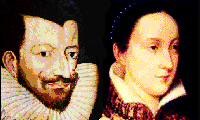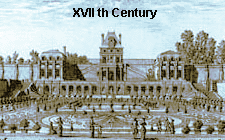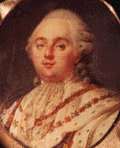
The Observatory campus occupies the upper part of an extensive park where once stood a splendid Renaissance Chateau (whose Communes entrance survives today) that was already used for royal festivities under François I, while the surrounding forest was used for hunting - including falconry, in which the ladies were active participants.


During the troubled century following the reformation, it belonged (like much else) to the overweening Guise family, ancestors via Mary d’Ecosse of Britain’s Stuart dynasty, and protectors of the author of Gargantua, Meudon curate Rabelais, an admirer, like Mary, of the literary Queen Marguerite from whom she learnt (too late) that « Hawking causes us to forget a thousand foolish thoughts ».
After the abrupt termination of their emulation of Icarus - by the execution, at royal command, of Mary in England, and of her cousins Henri and Louis de Guise in France - Marguerite’s grandson, Henri de Navarre, used Meudon as a temporary power base during the installation of the Bourbon dynasty in 1589, which united France and Navarre on the basis of a religious compromise, shortly before England and Scotland were similarly united on the basis of the authorised Bible translation by Mary’s son King James.
Proud of its Italianate Grotte - a source of inspiration for Mary’s mentor Ronsard - the Chateau was already a historic monument when King James (reputedly « the wisest fool in Christendom ») chose the philosopher Herbert of Montgomery (author of Cherbury’s Lutebook) as his ambassador to the Paris

court of Louis XIII. However it was not until the time of Louis XIV that the Meudon site again became particularly important, because of its strategic position midway between Paris and the new headquarters of Royal Government at Versailles. In the late XVIIth century the parc was landscaped on an extravagant scale by two royal ministers - the munificent Servian and the ruthless Louvois - with finishing touches master minded by the architect Le Nôtre, before being taken over by the heir to the throne, the Grand Dauphin.

In 1706 (at his father’s instigation) the Dauphin sacrificed the antique Grotte (despite its poetic sanctification by Ronsard) in order to use its location to supplement the existing Chateau Vieux by the addition of a gargantuan royal appartment block known as the Chateau Neuf. Major construction work on the plateau came to an end under the Dauphin’s descendant, Louis XV, who (under the influence of his effective minister of culture, Madame de Pompadour) preferred the cosier downhill Chateau de Bellevue (now a scientific campus of the CNRS) and who used the upper Meudon parc mainly for hunting. By that time, the use of the fusil de chasse had made shooting a popular, though not necessarily more effective, alternative to the traditional falconry that had been so fashionable at the time of Marguerite and Mary. (Hawking is still needed to stop Meudon pigeons from overflying Villacoublay.) After neglecting it during his earlier years, Louis XVI brought the Meudon palace back into royal use as a home for his eldest son, Louis-Joseph, in the hope that the alarming state of health of the little Dauphin would benefit from the feature that would later attract the astronomers, namely cleaner air than in downtown Paris or even Versailles.
It had been at Meudon that the first Bourbon monarch had been informed of his ascension as Henri IV, but this time - just 200 years later - the augury was reversed : the ill starred Dauphin died at the age of 7 in 1789, only a few weeks before the hunting party at which - again at Meudon - the disconsolate Louis XVI was informed of the fall of the Bastille that signalled the doom of his entire dynasty. His catastrophic fate was interpreted in some quarters as historical retribution for the decisive role King Louis (and particularly his royal navy) had played in the downfall of the Ancien Regime in North America. The high point of his reign had been the formal recognition of the independence of the United States at the treaty of Paris in 1783, an occasion on which it was auspicious that (like lute player Herbert at the court of Louis XIII) the American representative, Benjamin Franklin, should have been what was then known as a savant, meaning a member of the scientific community that was destined to take over (from royal courtiers) the guiding role in the development of Meudon.

It was not just for diplomatic activity that 1783 was an exceptionally memorable year in Paris. More immediately significant for the future of Meudon - from whose terrace it would have been telescopically observable - was the aerostatic realisation of the dream of Icarus, first using hot air, and shortly afterwards using the more effective hydrogen balloon technology invented by the physicist Jacques Charles. As a first hand witness of this epoch making breakthrough, Franklin lost no time in informing his correspondent Joseph Banks (discoverer of Australia with Captain Cook) who was then President of the Royal Society in London. Like the naively conservative King Louis (who feared air accidents) but for other reasons, Banks was reticent, recalling that it was British fundamental research - meaning the recent discovery of hydrogen by Henry Cavendish - that had made the French achievement possible, and suggesting that it was of less basic scientific interest than the the idea - put forward about the same time by Cambridge astrophysicist John Michel - of what is now called a black hole - something whose visual appearance would first be calculated at Meudon, though not until a couple of centuries later. Banks concluded his reply to Franklin with the prediction that, sooner or later, the art of flying would be developed for use in warfare. Within less that ten years, in the upshot of the revolution, it was destined to be at Meudon that this prophecy would first be fulfilled.




